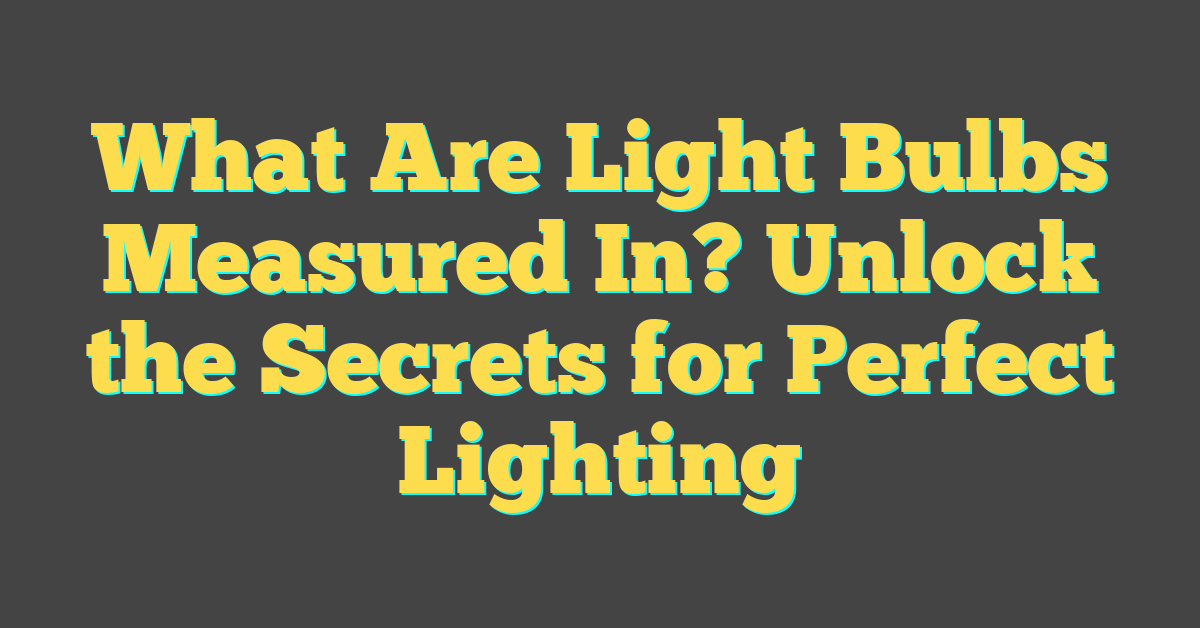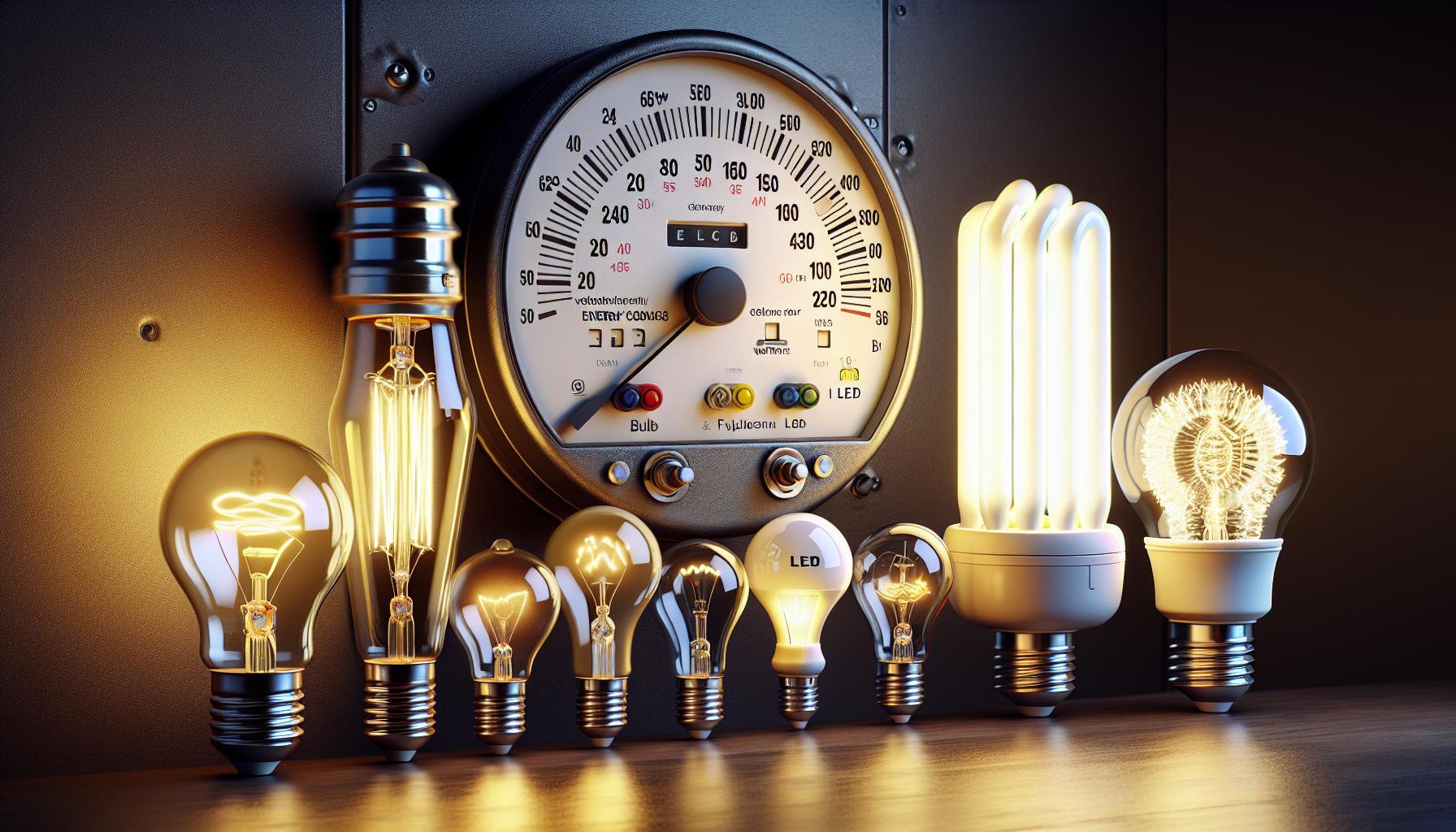Ever wondered how to compare light bulbs when you’re meandering through the aisles of your local hardware store? It’s not just about the wattage anymore. Light bulbs have evolved, and so have the ways they’re measured.

Understanding light bulb measurements can feel like learning a new language. But don’t worry, you’re about to become fluent. From lumens to watts and everything in between, you’ll be decoding those numbers on the packaging like a pro.
What are lumens?
You’re probably familiar with watts, the standard measure for the energy use of a light bulb. Lumens, on the other hand, are what you really need to be looking at when you’re tackling a lighting project. They actually measure something quite different: luminous flux. This is a fancy term for the amount of light a bulb emits—a critical piece of info for your next home DIY lighting adventure.
Think of lumens as the amount of brightness you get from a light bulb. The higher the lumens, the brighter the light. Unlike watts, lumens don’t tell you how much energy a bulb uses, but how much light you’re getting. This is crucial because you want to make sure your beautifully designed spaces are lit to showroom perfection, without wasting energy.
Here’s a handy reference for you:
| Brightness (Lumens) | Typical Incandescent Wattage |
|---|---|
| 450 lumens | 40 watts |
| 800 lumens | 60 watts |
| 1600 lumens | 100 watts |
| 2600 lumens | 150 watts |
This table suggests incandescent bulbs you might be replacing, but remember, for the same lumen output, LED bulbs consume far fewer watts, making them more energy-efficient and your go-to choice for cost-saving lighting projects.
It’s also worth noting that the color temperature, measured in Kelvin, influences the mood and function of your space but doesn’t affect brightness. Soft white, which is typically 2700K – 3000K gives a warm, cozy feel, while daylight bulbs, with a cooler 5000K – 6500K, mimic natural sunlight and are great for concentration.
When you’re browsing light bulb options, flip the box and look for the lumens. It’s like reading a nutrition label for your light bulbs—chock-full of data to make sure you’re purchasing the perfect bulb for your needs.
How are lumens different from watts?

Lumens and watts are terms often used interchangeably when it comes to light bulbs, but understanding the difference is crucial for your home DIY lighting projects. Imagine watts as a measurement of the energy a light bulb consumes, while lumens are all about the amount of light the bulb emits. It’s the difference between the bulb’s appetite for power and its ability to light up your space.
Consider watts the input and lumens the output. Picture yourself turning on a light: the immediate effect you see, that bright or dim light, that’s the lumens doing their work. The silent process happening within the bulb, using up electricity, that’s all about watts. In the past, with incandescent bulbs, higher watts generally meant brighter light. But that rule doesn’t apply with newer technology like LEDs and CFLs.
Here’s a simplified way to look at it:
- Watts: Energy used
- Lumens: Brightness produced
| Incandescent Wattage | Lumens Equivalent |
|---|---|
| 40 watts | ~450 lumens |
| 60 watts | ~800 lumens |
| 75 watts | ~1100 lumens |
| 100 watts | ~1600 lumens |
Obviously, with energy efficiency being a significant concern, you’ll want to get the brightest light for the least wattage. That’s where LED bulbs steal the show. They demand much less power for the same, or often more, light output. This is why checking the lumens is the key to finding what you need.
Light quality goes beyond brightness, though. It touches on how colors appear under the light and how the brightness feels to your eyes. The color temperature, measured in Kelvin, also shapes the experience. But when it boils down to sheer brightness, lumens are your go-to measure, not watts. They directly correspond to how much light you’ll get.
So, for your next project, pay attention to those lumen numbers. They’ll give you a clear picture of how well-lit your area will be. Whether you’re spotlighting your latest art acquisition or setting a soft mood in your reading nook, it’s all about those lumens.
The role of wattage in light bulbs
« How Do Light Bulbs Help Us: Discover the Surprising Benefits for Home and Health
What Light Bulbs Work with Smart Life App: Unveil Compatible Models Now »

Have you ever wondered how your light bulb impacts your electricity bill? Wattage is where the story begins. Think of wattage as a measure of electrical power representing the rate at which a bulb consumes energy. The higher the wattage, the more power it gobbles up.
Let’s say you’ve got a flair for DIY projects and a love for well-lit spaces. You’ll want to know that traditional incandescent bulbs once dominated the market with their familiar glow and warmth, typically run on higher wattages like 60W, 75W, or even 100W. But they’re essentially energy guzzlers when compared to the modern LED or CFL bulbs.
In the DIY world, you might be swapping out old fixtures or installing dimmers and understanding wattage will guide you in choosing the right bulb. It’s simple – the higher the wattage, the more robust your dimmer or fixture needs to be.
But here’s the twist: wattage doesn’t tell you how bright the bulb is, just how much energy it uses.
- LED bulbs are the game-changers in this scenario. They can produce the same brightness with much less power.
- CFLs (Compact Fluorescent Lamps) are another energy-saving option, although with a different set of pros and cons compared to LEDs.
A quick peek at the following table will reveal just how different these bulbs are when it comes to wattage consumption:
| Incandescent Bulb Wattage | LED Bulb Wattage (Approximate) |
|---|---|
| 60W | 10W |
| 75W | 11W-15W |
| 100W | 14W-17W |
Enthusiasts in home lighting should focus not just on the immediate brightness or wattage but also on the long-term impact on energy bills. Efficient lighting not only reduces your carbon footprint but also offers substantial savings over time.
As you fine-tune your living spaces to create that perfect ambience or highlight your latest painting, remember that wattage is more than just a number on the packaging—it’s an integral part of your lighting choices, affecting both ambiance and economics.
Other important measurements for light bulbs

Apart from wattage, lumens are vital in understanding light bulb efficiency. Lumens measure the total amount of visible light emitted by a bulb, effectively quantifying brightness. When you’re browsing the aisle for bulbs, comparing lumens gives you a truer sense of how much light to expect. The higher the lumen count, the brighter the light.
Color temperature, measured in Kelvins, is another crucial aspect. It indicates the warmth or coolness of the light appearance. Lower Kelvin numbers mean the light is warmer and offers a cozy, yellowish glow, much like the soft, inviting light of a setting sun. Conversely, higher Kelvins equate to cooler, whiter light reminiscent of daylight.
To ensure you’re making the right choice for your space, take note of a bulb’s Color Rendering Index (CRI). CRI measures the ability of the light to reveal the true colors of objects compared to a natural light source. Bulbs with a high CRI make colors pop and textures stand out, transforming the look and feel of your surroundings.
Don’t forget about anticipated lifespan. LED and CFL bulbs boast substantial lifespans, often lasting years longer than traditional incandescent bulbs. This longevity can save you the hassle of frequent changes and reduce waste over time.
Finally, consider the bulb’s energy efficiency rating. Look for the ENERGY STAR label to ensure you’re purchasing a bulb that promises maximum efficiency and cost savings. These bulbs might cost more upfront but typically pay for themselves through prolonged use and lower electricity bills.
Remember, when you’re tackling your next DIY lighting project or simply looking to revitalize a room, factoring in lumens, color temperature, CRI, lifespan, and efficiency can dramatically enhance the atmosphere and energy consciousness of your space. Keep an eye on these measurements, and you’re sure to find the perfect light bulb that meets both your aesthetic desires and practical needs.
Conclusion
You’ve got all the info you need to light up your space just the way you want it. Remember, it’s not just about wattage anymore. Brightness, color, and efficiency all play a part in creating the perfect ambiance and keeping your energy bills in check. So next time you’re bulb shopping, think lumens for brightness, color temperature for mood, and CRI for true-to-life colors. And don’t forget, LED and CFL bulbs will keep shining long after traditional bulbs have dimmed. Happy lighting!
Frequently Asked Questions
What does wattage mean when choosing a light bulb?
Wattage measures how much energy a light bulb consumes. Lower wattage bulbs use less energy, making them more energy-efficient and cost-effective in the long run.
How does lumen rating affect light bulb brightness?
Lumens measure the amount of light emitted by a bulb; the higher the lumens, the brighter the bulb. Choose a higher lumen rating for spaces that require more brightness.
What is color temperature in light bulbs?
Color temperature is a way to describe the light appearance provided by a bulb, expressed in Kelvin (K). Lower Kelvin values mean warmer, yellowish light, while higher Kelvin values produce cooler, bluish light.
Why is Color Rendering Index (CRI) important?
CRI rates a bulb’s ability to reveal the colors of objects faithfully in comparison to natural light. A higher CRI means colors appear more accurately, enhancing the ambiance of a space.
What are the advantages of LED and CFL light bulbs?
LED and CFL bulbs offer longer lifespans and higher energy efficiency compared to traditional incandescent bulbs. They consume less energy and last longer, saving money on energy bills and replacement costs.
How do I choose the best light bulb for my space?
Consider the brightness (lumens), color temperature (Kelvin), and CRI based on the ambiance you want to create. Look for energy-efficient options like LED or CFL for cost savings and environmental benefits. Factor in bulb lifespan to reduce the frequency of replacements.




